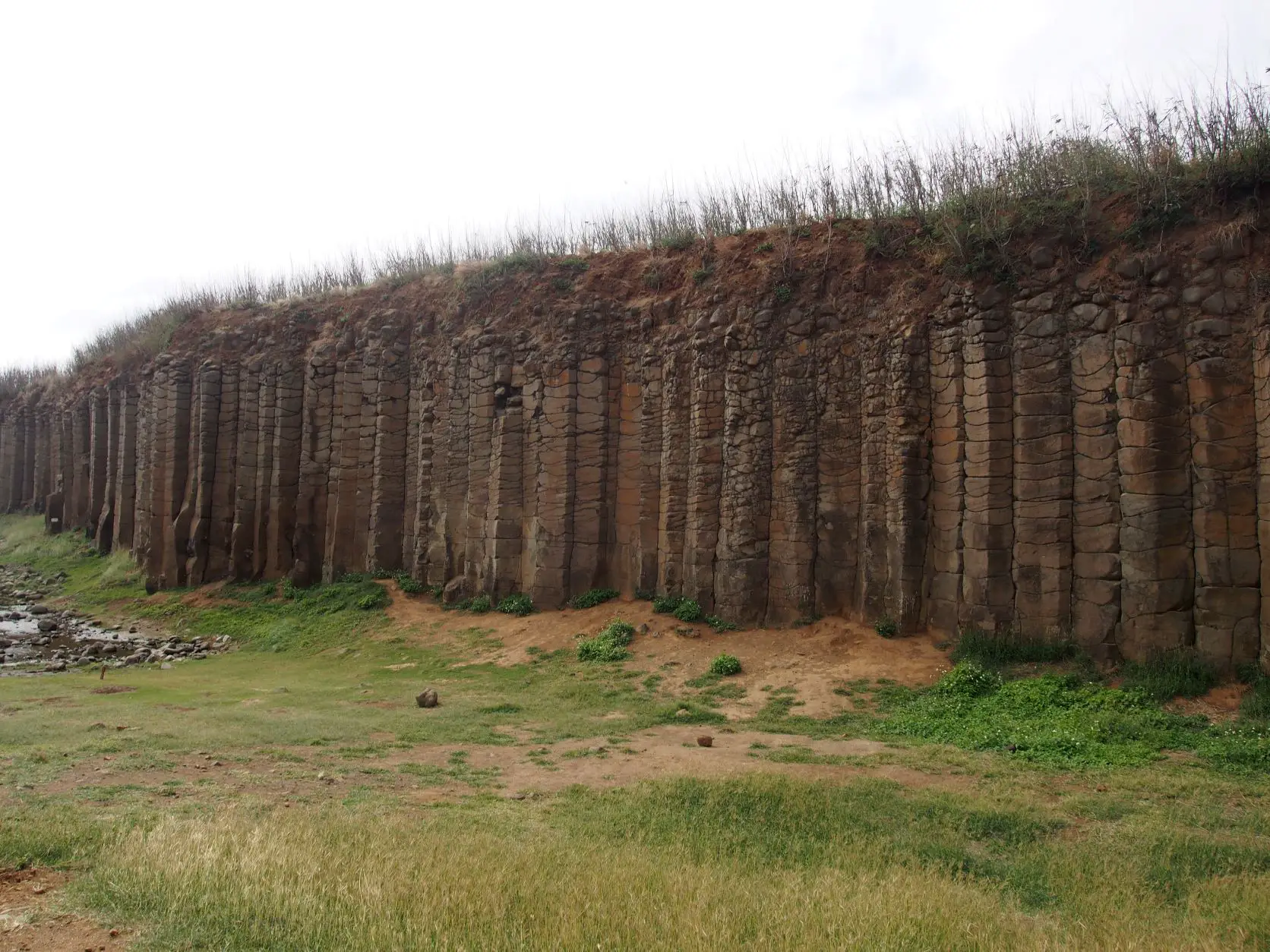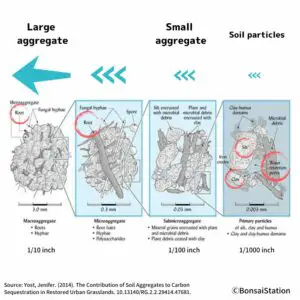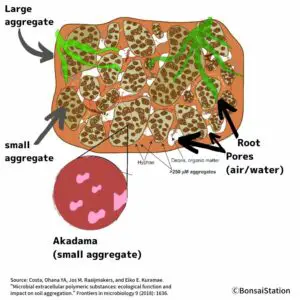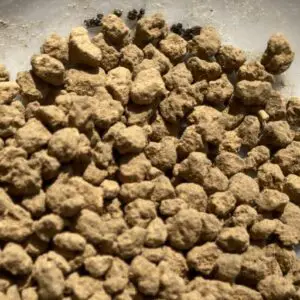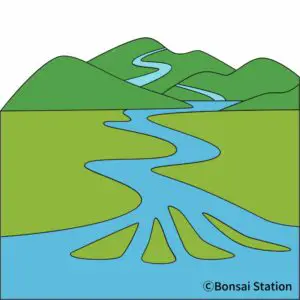Mini bonsai trees grow in a severe environment as they are planted in tiny pots compared to their size. It is thus crucial to use the right soil for their health.
While mini bonsai soil mix should be altered according to the climate you live in and the environment where you place your mini bonsai trees, here are the guidelines. Coniferous trees: akadama- 60%, sand- 40%; deciduous trees: akadama- 80%, sand- 10%, organic compost: 10%; fruits/flower trees: akadama- 70%, sand- 20%, organic compost- 10%.
Let’s discuss in detail.
Good soil vs. good bonsai soil: can normal soil be used?
What is soil?
Soil structure
Soil is not a collection of some small individual particles. It is rather a mass of larger groups of soil particles consisting of varying sizes and shapes called aggregates. These groups of soil particles are bound to each other more strongly than to adjacent particles.
The manner of this aggregation defines a soil’s structure and the space between the aggregates provides pore spaces that enable the retention and exchange of air and water.
※Click to enlarge
Pore space
Pores are spaces within and among aggregates of varying sizes; large pores between the aggregates and smaller pores within the aggregates. The pore space between aggregates is essential for water/air entry and exchange. This pore space also provides zones of weakness through which plant roots can grow.
※Click to enlarge
A well-structured soil has both large pores and tiny pores; this provides a balance of the air and water that plants need. Large pores provide for good drainage, and small pores hold water that plants can access. This helps explain how you can achieve a “well-drained but moist soil”.
What is good soil
Generally speaking, good horticultural soil should contain the following:
- 50% solid material (mostly minerals + 5-10% organic matter) and
- 50% pore space (air and water).
Pore spaces are important. When water is given, all the pores are temporarily filled with water. The water in the large pores flows down with gravity quite quickly, being exchanged with air while the water in the small pores is maintained.
Organic matter for good soil
While the organic portion makes up only 0.5% to 5% of most native soils, well-amended garden soil may contain 30% or more organic matter. Organic portion is deemed the most important factor in improving normal potting soil for plants.
What is good bonsai soil
Bonsai soil requirements
Bonsai soil requires;
- good water retention
- good drainage and
- good aeration.
Bonsai trees, like all other plants, need water to create energy through photosynthesis and oxygen for root respiration. So the soil with good water retention, drainage and aeration enable stable and healthy growth of bonsai trees.
Is organic matter necessary in bonsai soil?
Bonsai soil must contain little or no organic matter but should be able to hold the nutrients when we fertilize them.
If the soil of bonsai is rich in nutrients, controling the strength of tree growth becomes harder as the trees grow vigorously. Bonsai trees are small but they should look like big trees, so managing the growth by cutting the nutrients in the soil should be a priority.
This is the main difference between good soil and good bonsai soil; the existence and necessity of organic matter in the soil.
Can normal potting soil be used as bonsai soil?
Using normal nursery organic soil for your bonsai tree is not recommended. Normal potting soil mix usually contains more organic matter than it needs for bonsai soil.
Best soil mix for mini bonsai trees
Types of soil used in mini bonsai mix
Main types of soil used in mini bonsai soil mix are;
- Akadama (lava soil)
- Volcanic/river sand and
- Organic potting compost.
Akadama
Akadama is volcanic ash found in the northern Tokyo area. It is found naturally in a grain-like shape, with a size of 0.1-0.4 inches on average. Akadama is a soil aggregate; there are a lot of pores through which fine bonsai roots can grow.
For more detail about Akadama, please refer to the following post.
Volcanic sand
Volcanic sand is lava sand that erupts from a volcano. It is black or reddish-brown in color, porous and is in sharp and angular form. It has high aeration but low water retention ability.
As it is blackish in color and retains heat, you need to be careful when you use it in summer because it absorbs heat greatly.
River sand
River sand is the type of sand collected from the river bed that is made from weathering or erosion processes of rocks.
River sand for bonsai soil should be the one collected upstream. Those collected upstream have a sharp and angular form as erosion in the water currents has not progressed. This sand drains water well but can hold water to some extent as well.
River sand collected downstream, on the other hand, is usually fine, round and polished as it is rubbed in the water currents. This type of river sand drains water very well but cannot hold water, which is not ideal for bonsai soil.
For more detail about river sand, please refer to the following post.
Organic potting compost
Organic potting compost, like humus, is a dark, soft and light-weighted organic matter formed by the decomposition of animals or/and plants. It is rich in nutrients and retains moisture while having adequate drainage.
Organic potting compost is never used alone as bonsai soil.
Is lava rock (volcanic soil) good for bonsai?
Characteristics of volcanic soil
Lava rock = volcanic soil is formed from lava erupted from a volcano. Characteristics of volcanic soil are;
- High porosity: good drainage and aeration
- High water content at natural state: greasy texture, not sticky
- High water retention capability
- Ability to recover when applied pressure: Under normal circumstances, the soil behaves as a solid, but under sudden pressure, it may liquefy for a brief period and flow.
So volcanic soil has all the characteristics necessary for bonsai and can be used as bonsai soil. In fact, Akadama is a kind of volcanic soil found in Japan.
Points to pay attention to when purchasing volcanic soil
Not all volcanic soils are the same and have the qualities fit for bonsai. Some are good for bonsai trees but others are not. You should pay attention to the following points when you buy volcanic soil for bonsai:
- whether the one you are buying meets the requirements of bonsai soil (good water retention, drainage and aeration)
- chemical properties (including pH) and
- whether it is a soil aggregate.
While most bonsai species perform well in soil with pH 6.0 – 7.0 (slightly acidic to neutral), volcanic soil could be alkaline depending on where it comes from.
And the volcanic soil you are buying might not be a soil aggregate that enables fine roots to grow through it. This is not a “must” quality for bonsai soil but it helps to nurture a healthy growth for your mini bonsai tree. Akadama is praised by many bonsai enthusiasts because of this quality.
Recommended mini bonsai soil mix
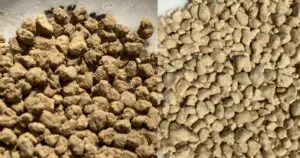
Is there an ideal bonsai soil mix that can be used anytime/everywhere?
The soil mix should be altered according to the climate you live in and the environment where you place your mini bonsai trees.
If you live in California whose climate is warm and dry year-round, you might want to use less sand and the kind of soil to retain more water. But if you live in New Jersey whose climate is hot and humid in summer but very cold and snowy in winter, you might want to use more sand for drainage and protection from freezing.
You might also have to consider where you place your mini bonsai trees. The soil mix has to be altered depending on whether you place your trees outdoors under the sun or indoors with less sunlight, or if your trees are being tailored or fully-grown ones.
Using soil that is suitable to the environment will improve the vigor and make the tree healthy.
Having said that, here are the guidelines for the mini bonsai soil mix. You can alter the soil mix in an appropriate combination using these guidelines.
Preparation of soil mix
To prepare mini bonsai soil mix, it is absolutely crucial;
- to get rid of silt (particles less than 0.04 inchs/1mm in diameter) from the soil and
- to sieve the soil to gather 0.06-0.08 inches/1.5-2mm size of soil.
- First, use soil sieve of 3mm (0.1 inches) to get rid of larger particles.
- Use then the sieve of 0.8mm (0.03 inches) to remove silt. The remaining soil is the one you use for bonsai soil.
- Repeat the process for each type of soil.
- Put each kind of soil in different containers so that you can mix them later.
Why get rid of silt?
If the soil contains fine particles like silt, the soil becomes muddy when water is given, and hardens when dried. This kind of soil has very little room to contain air and does not allow water to pass through. The roots cannot breathe and drown in water.
Why only small particles?
Small particles of soil can retain water more than the larger ones, which is desirable for mini bonsai whose pots contain very little soil. Also, larger particles would hardly fit in the tiny pots of mini bonsai trees. In addition, small soil particles facilitate the growth of fine roots rather than large, long roots.
Recommended mini bonsai soil mix
Coniferous trees

Black pine
- Akadama: 60%
- River/volcanic sand: 40%
✓ High percentage of sand is necessary for coniferous trees for good drainage.
✓ No organic compost should be added because coniferous trees prefer soil with good drainage. Also, little nutrients make the tree balk rough and make it look old/ancient.
Deciduous trees
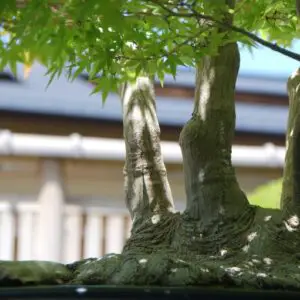
Japanese maple
- Akadama: 80%
- River/volcanic sand: 10%
- Organic compost: 10%
✓ Organic compost is added to make spaces for fine roots to grow, which is the characteristic of deciduous trees. Sieve the organic compost well. Bigger particles impair drainage.
✓ Sand is added to improve water retention and aeration to encourage the growth of trunks and vigor. Adding more than 20% will end up in the overgrowth of the tree.
Fruits/flower trees
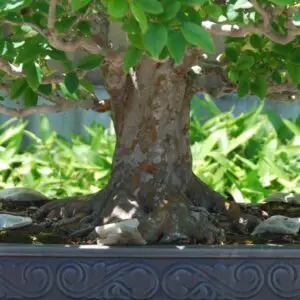
Chinese quince
- Akadama: 70%
- River/volcanic sand: 20%
- Organic compost: 10%
✓ Organic compost is added for nutrients to fruits/ flowers. Sieve the organic compost well. Bigger particles impair drainage.
✓ Sand is added to improve water retention and aeration to encourage the growth of flower buds and fruits.
—–
Reference
“Soil Quality Indicators: Aggregate Stability”. USDA Natural Resources Conservation Service. (Link here)
“Improving aggregate stability”. Cornell University Cooperative Extension. (Link here)
“Volcanic soils”. (Massey University) (Link here)
“Garden good guys- soil”. University of California, Agriculture and Natural Resources. (Link here)
“Soil and plant nutrition”. University of Maine. (Link here)

